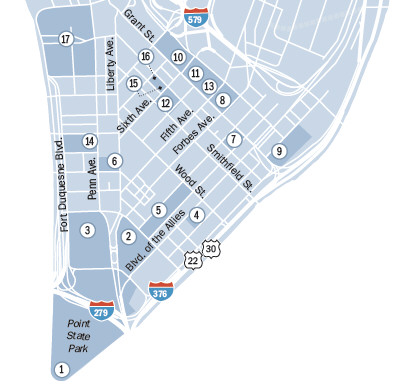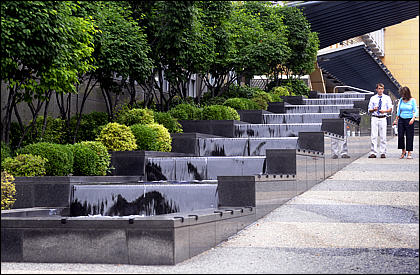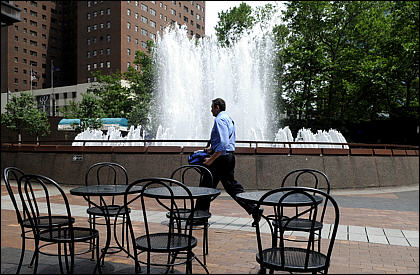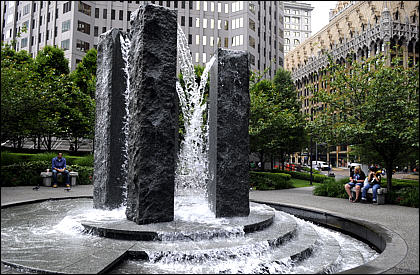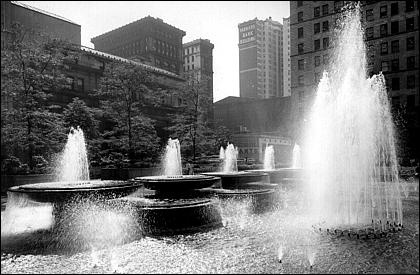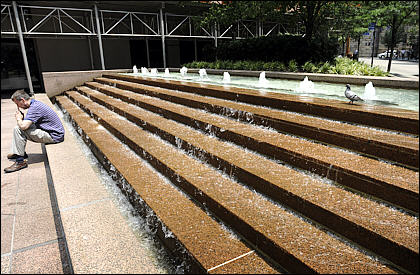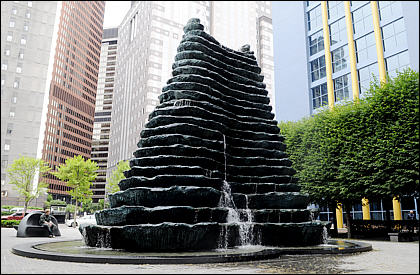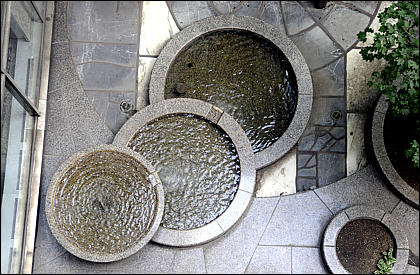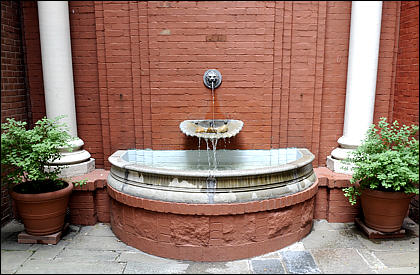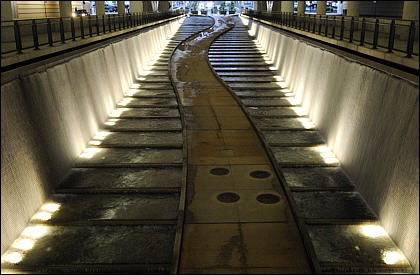
Category Archive: Architecture & Architects
-
Firms Pitch Building Plans for Garden Theater Area
By Bill Vidonic
PITTSBURGH TRIBUNE-REVIEW
Tuesday, July 20, 2010The owner of a central North Side business only wanted to hear one issue addressed Monday about the redevelopment of the block surrounding the vacant Garden Theater.
“Parking, parking, parking,” said Irene Karavolos, co-owner of Steve’s New York Hot Dogs on Federal Street. “You can’t bring in more businesses when little businesses already are starving for parking.”
More than 200 people crowded into an auditorium at the Children’s Museum of Pittsburgh to hear several proposals for the block surrounding the former X-rated theater, with five developers promising to spend tens of millions of dollars to revitalize the blighted section of the North Side.
All submitted proposals calling for a mix of retail and residential development; two called for the partial or complete destruction of the vacant Garden Theater auditorium.
Kirk Burkley, president of Northside Tomorrow, which is coordinating redevelopment efforts, said the Garden wouldn’t vanish entirely under any of the proposals. City and national historical designations mean the building’s facade must be preserved.
“This project affects more than just the central North Side,” Burkley said.
North Side resident Matt Long said he’d like to see the Garden restored as an independent filmhouse.
“I don’t think retail would be what I’d put there,” Long said.
Tom Hardy, a consultant with Northside Tomorrow, said a decision could come in the next couple of months.
“We have some momentum now,” Hardy said. “There’s an interest in keeping that momentum going.”
North Side visionsDevelopment proposals for the Garden Theater block:
• Barron Commercial Real Estate, Pittsburgh: Demolish the former Garden Theater auditorium, but preserve and restore the remaining historic properties into a mix of housing and retail development.
• Wells and Company, Spokane, Wash.: Restore the Garden Theater auditorium for a performing arts center; build apartments in the former Masonic building, along with a first-floor restaurant/brew pub; and restore buildings along West North Avenue and Reddour Street.
• Zukin Development Corp., Philadelphia: Create retail space, including a specialty grocery store, by demolishing part of the Garden Theater; create retail space and apartments in the Masonic Hall, the Bradberry apartment building and other properties.
• Aaron Stubna and William Porco, Coraopolis: Convert the Garden into a multi-purpose theater hosting live entertainment and films.
• Resaca LLC, Pittsburgh: Redevelop the Bradberry into 16 one-bedroom apartments.
Source: Northside Tomorrow LLC
-
North Side Theater is “Spruced Up” — for Hollywood
By Bill Vidonic
PITTSBURGH TRIBUNE-REVIEW
Friday, July 16, 2010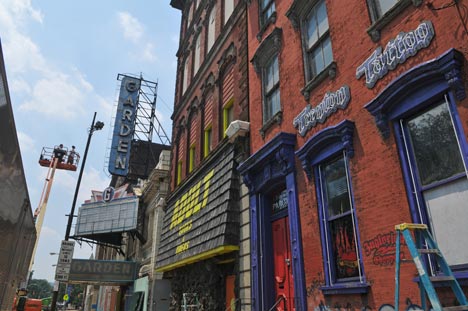
Workers are transforming the old Garden Theater and surrounding buildings in the North Side into a seedy city block of Trenton, N.J., in preparation for filming next week of the movie "One for the Money," starring Katherine Heigl. JC Schisler | Tribune-Review
More than one person passing the former Garden Theater in the North Side did a double-take Thursday, likely wondering whether a decade of working to rid the block of porn establishments suddenly reversed.
Workers replaced the neon on the old X-rated theater’s dilapidated sign. Next door, a painter finished the words “Adult Books and Videos” on the old Apache Bar facade, while others put finishing touches on the Trenton Tattoo parlor, complete with neon lights and spray-painted graffiti.
“(Former) Mayor Murphy took a nap, and here’s what happened,” painter Darien D’Alfonso joked.
Turns out it’s just movie magic.
A production crew for the film “One For the Money” starring Katherine Heigl is transforming the blighted city block into a seedy Trenton, N.J., street; filming starts Wednesday.
That means bringing the exterior of the Garden back to life and creating fake businesses, including a hoagie shop, from vacant storefronts.
“From our perspective, it’s quite ironic, but at the same time it’s exciting,” said Joanna Doven, spokeswoman for Pittsburgh Mayor Luke Ravenstahl. “There are good positive things happening in that area.”
The city spent millions in a lengthy legal battle to clear dilapidated buildings from the section of North Avenue near Allegheny General Hospital before it bought the Garden for $1.1 million in 2007.
“I think it’s great if it’s bringing the city some money,” neighbor Laurie Charlton said about the movie production. “Everybody in the neighborhood is excited about this block coming back to life.”
The Northside Leadership Conference is accepting redevelopment proposals for the Garden and surrounding buildings. A meeting about the redevelopment is scheduled for 6 p.m. Monday in the Children’s Museum.
“It’s a new day there soon,” Doven said.
For a little while longer, though, it will look like the old days.
“I think it’s kinda stupid,” North Side resident William McCue said. “They could have just been here three or four years ago, and everything would have been open for them.”
-
McKeesport Will Demolish 15 Homes
Thursday, July 15, 2010By Candy WoodallMcKeesport’s 7th Ward is getting a face-lift.
Despite a poor economy, McKeesport continues to attract stimulus dollars to improve its neighborhoods.
Using a $100,00 from Allegheny County, Mayor James Brewster said the city will raze another 15 blighted homes along Bailey Avenue, beginning on July 27.
“We’re tearing down a house every four days,” he said.
Mr. Brewster has worked to remove half of McKeesport’s 600 blighted properties since he took office seven years ago, calling them fire and public safety hazards.
Old, boarded-up houses aren’t the only things coming down in the 7th Ward.
Cornell Intermediate School is being demolished to make way for the new Cornell Elementary/Intermediate School being built on the same property as part of McKeesport Area School District’s $46.4 million plan to build two new schools and renovate a third.
The Cornell construction will cost $29 million and help revitalize the neighborhood, according to Superintendent Michael Brinkos.
It is being developed as a green building that will accommodate kindergarten through sixth grade, featuring state-of-the-art facilities and technology, he said.
A public hearing was held Monday in the district’s board room regarding the school’s construction plans.
In addition to removing blight and replacing a 94-year-old school with a new one, City Council also unanimously approved an agreement with McKeesport Neighborhood Initiative to begin $1.4 million of housing development in the Seventh Ward.
“That will complement the new Cornell school,” Mr. Brewster said.
A Weed & Seed initiative will offer help in the 7th Ward, which is a target area along with the 2nd, 3rd and 5th wards.
As a local branch snags funds from Pennsylvania’s recently passed budget, it will work to fulfill the goals of Weed & Seed, a national program that seeks to improve conditions in high-crime neighborhoods.
The city’s Weed & Seed will have $75,000 from the state and $8,330 from the city for an $83,330 budget for the coming year, said Dennis Pittman, city administrator.
The money is earmarked for prevention and intervention programs and pairs with law enforcement efforts.
-
Group Asks 1-Year Delay in Mellon Arena Demolition
Thursday, July 15, 2010By Mark Belko, Pittsburgh Post-GazetteA group seeking to save Mellon Arena today urged its owner to delay a proposed demolition for one year.
Rob Pfaffmann, a Downtown architect who leads Reuse the Igloo, asked the city-Allegheny County Sports & Exhibition Authority board to give the group a year to develop an economically viable plan to save the Igloo. The SEA owns the building.
“We do not want to see a white elephant,” he said.
Mr. Pfaffmann said the group also would develop a plan to help the SEA cover the operating costs of the building while a more thorough planning process is undertaken and alternatives are studied.
“We should not rush to judgment on this if we have an economic circumstance that doesn’t demand it,” he said.
Mr. Pfaffmann was among about 10 people to speak at the SEA meeting today in favor of saving the building.
“There’s no do over. Once it’s gone, it’s gone and it will never be back again,” said Nancy Motz Cosnotti. “If the Civic Arena is gone, then part of Pittsburgh will be gone and I don’t want that.”
Reuse the Igloo also would like to see the SEA open the arena’s distinctive dome as a demonstration to see if it still works and to determine the cost of operating it.
SEA Executive Director Mary Conturo said no vote has been scheduled yet on a demolition, favored by the Penguins, Mayor Luke Ravenstahl and county Executive Dan Onorato.
She said the SEA is still in the process of reviewing options through an ongoing historic review process.
Asked whether the SEA would agree to a one-year delay, board chairman Wayne Fontana said the request would be taken under advisement.
“I’m not adverse to anything at this point,” he said.
-
Former Turtle Creek High School’s Architecture, Importance Honored
By Tom Fontaine
PITTSBURGH TRIBUNE-REVIEW
Thursday, July 15, 2010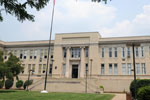
On Saturday, officials will unveil two historical markers that commemorate the former Turtle Creek High School building's architectural significance and role in the community. Officials debated about demolishing the building five years ago, but a group led by former graduates Jill Hinkle, Bob Mock, Jeanne Flaherty and Connie Morenzi led vocal opposition. The Classical Revival-style, cream-colored brick building with stone and terra cotta trim was designed by Pittsburgh architect George Henry Schwan. Jasmine Goldband | Tribune-Review
The former Turtle Creek High School building has gone by several names and narrowly avoided the wrecking ball to remain a community centerpiece since opening during World War I.
On Saturday, officials will unveil two historical markers that commemorate the Monroeville Avenue building’s architectural significance and role in the community.
Although the markers were installed last week, the building was placed on the National Register of Historic Places three years ago and received historic designation last fall from the Pittsburgh History and Landmarks Foundation.
“It basically validates what people in Turtle Creek have felt all along,” said councilwoman Jill Henkel of the markers. Henkel is a 1978 graduate of the former Turtle Creek High School and one of four Turtle Creek natives who led a push to obtain historical designation for the building.
Ground was broken on the $200,000 building in August 1917, and it opened in February 1919 as Union High School, with students from Turtle Creek, Wilmerding, East Pittsburgh and parts of nine other communities, according to documents related to the National Register of Historic Places designation.
The Classical Revival-style, cream-colored brick building with stone and terra cotta trim was designed by Pittsburgh architect George Henry Schwan. He also designed the Twentieth Century Club’s original building in Oakland, the former Oakmont High School and laid out plans for factory-worker developments in Aliquippa and Akron, Ohio.
The building wasn’t home to just high school classes.
Westinghouse employees trained at night in classrooms and vocational shops. Women used school sewing machines after hours to earn money during the Great Depression. And the school’s large lawn provided “the only open green space in the borough,” Henkel said.
“Even today, people are always playing in it,” Henkel said of the lawn. “It’s basically a community park.”
The school would hit a peak enrollment of more than 2,100 students in the 1930s. Also in that decade, after East Pittsburgh and Wilmerding opened their own high schools, Union’s name was changed to Turtle Creek High School. In 1940, the school graduated just 365 students.
When Turtle Creek became part of the newly created Woodland Hills School District in the 1980s, the building became the new district’s East Junior High. Officials debated about demolishing the building five years ago, but a group led by former graduates Hinkle, Bob Mock, Jeanne Flaherty and Connie Morenzi led vocal opposition.
Ultimately, the district moved East Junior High students elsewhere and mothballed the Turtle Creek building for the 2008-09 school year; it reopened last August, housing the district’s new Woodland Hills Academy for elementary students.
“I would have laid down in front of the bulldozer if they tried to tear down the building,” said Mock, a 1968 graduate.
The unveiling of the marker, part of Turtle Creek Community Days festivities, begins at 7:30 p.m. on Saturday at 126 Monroeville Ave.
-
Steel Valley Agency Eyes Old Gym For After-School Use
By Chris Ramirez
PITTSBURGH TRIBUNE-REVIEW
Thursday, July 15, 2010
Christian Michaels, 8, shoots hoops during a summer camp at Homestead United Prebyterian Church in Homestead. The camp is organized by the Methodist Union of Social Agencies, or MUSA, which wants to run after school programs for middle school children in the Steel Valley Council of Governments' gymnasium. James Knox | Tribune-Review
Decades ago, the old gymnasium attached to the Steel Valley Council of Governments building was the place to go for pick-up basketball games and summer youth camps.
Not so much now.
Amid the walls, streaked with unsightly graffiti and time-yellowed pin-ups, the Rev. Jim Cannistraci sees potential.
He and a small-but-growing band of community leaders are trying to generate local support — and money — to convert the aging gym into a state-licensed center for programs that cater to middle school children.
“This isn’t my dream. It’s the dream of the community,” said Cannistraci, executive director of the Methodist Union of Social Agencies. “People want this and people need this.”
They envision starting a program that would see to the needs of children from West Homestead, Munhall and Homestead, where half the population is black and one in four residents lives below the poverty line, according to U.S. Census figures.
Among services Cannistraci hopes can be offered at the center would be help with homework, access to computer labs and career exploration sessions. The Methodist Union wants the program to start Sept. 1, but needs to raise more than $100,000 before then for improvements to the gym.
Cannistraci envisions the program serving about 50 students by the end of the upcoming school year, but expects it eventually to cater to as many as 125.
“A lot of kids get out of school at three, but their parents are still at work. That’s also when they face a lot of temptation to do things that can get them in trouble,” said Douglas R. Spencer, executive director for the Allegheny Children’s Initiative, a South Side nonprofit pushing for the change. “That time needs to be occupied with structured activities.”

RaVyn Wright, 9, (left) and Edaiza Sands, 10, have fun playing computer games during a summer camp at Homestead United Prebyterian Church in Homestead. The camp is organized by the Methodist Union of Social Agencies, or MUSA, which is looking to generate funds to renovate the former gym and building that belonged to Homestead High School for an after school program that would see to the needs of children from West Homestead, Munhall and Homestead.
Homestead does not have a YMCA, Boys and Girls clubs or a private community center for middle school students to go to in the afternoon as neighboring communities do. A local chapter of the Salvation Army offers a free after-school program for children ages 6 to 12, and Methodist Union of Social Agencies holds after-school programs at Barrett and Park elementary schools.
For more than 80 years, the Methodist Union has aided families and children of the Mon and Steel valleys. The past three decades have been among the most challenging as the two areas struggle to find solid financial footing in the wake of the steel industry’s collapse.
Last week, the Steel Valley Council of Governments, which owns the gym, examined the prospect of an after-school program at a public meeting.
The gym for years belonged to Homestead High School and often was the backdrop to basketball games and large student assemblies. But that changed in 1979 when the Homestead school district merged with West Homestead and Munhall to form the Steel Valley School District.
The Allegheny Works program, which offered job-training programs and operated out of the old high school as the collapse of the steel industry began in the 1980s, used the gym for workshops for many years. These days, however, the gym is used only sparingly.
The Steel Valley Council of Governments says the gym is habitable, but $750,000 is needed to make it usable for a variety of purposes in addition to the after-school program.
-
Pittsburgh Offers Plenty of Refreshing Water Havens During the Summer Months: A Walking Tour of the City’s Fountains and Water Feaures
Sunday, July 11, 2010By Bill Toland, Virginia Linn, Patricia Lowry, Marylynne Pitz and Katy Buchanan, Pittsburgh Post-GazetteOur crown jewel fountain at Point State Park (No. 1 on the map above) is dry until 2012 while it undergoes repairs, and a few others also need work, but there are plenty of other burbling basins to enjoy in the city. Some are old, some are new, some tucked away and some in plain view. But they all make a splash, so put on your walking shoes, follow this guide and discover the cool fountains of Downtown Pittsburgh.
__________________________________________________________________________ 1. Point State Park
DETAILS: When it rose for the first time on July 23, 1974, the fountain in Point State Park sprayed a geyser of water that was 150 feet high.
At its formal dedication that August, the magnificent column of water signified the park’s completion, the importance of rivers to the region’s growth and the city’s first renaissance.
The fountain cost $1 million and the 6,000 gallons of water that circulate through it each minute come from Pittsburgh’s “fourth river,” which flows 54 feet underground. When running, 800,000 gallons of city water recirculate through it daily.
Designed by Ralph Griswold and Charles Stotz, the fountain has experienced its share of problems, including flooding that deposits mud, silt, logs and other debris.
Between 2007 and 2012, Point State Park and its fountain will have been renovated at a cost of $42 million.
“It’s the largest park project in commonwealth history,” said Edward Patton, director of capital projects for Riverlife, a public-private partnership whose mission is to improve the region’s riverfronts.
The fountain’s circular base is 200 feet in diameter. Plans call for cleaning its circular granite rim and adding a second, higher tier over which water will flow into the basin at the rim level. People standing on the great lawn will be able to see the overflow tier.
The plaza around the fountain will be raised 18 inches, making it easy for visitors to sit on the rim and access its water. The sandstone block plaza will be dug up, cleaned and relaid. For the present, the fountain is inaccessible during construction.
2. TrizecHahn Plaza (formerly Equitable Plaza)Bounded by Liberty Avenue, Stanwix Street and Boulevard of the Allies
COMPLETED: 1961
DETAILS: The plaza sandwiched by the former state office building on the west and Gateway Four and the Verizon Building on the east was designed by Simonds and Simonds, Pittsburgh’s renowned landscape architecture firm (now known as Environmental Planning and Design). It features shady pergolas, benches, planting beds and two rectangular, nearly flat fountain basins, one hidden at the back where the plaza segues into a walkway over the Boulevard of the Allies.
A partial redesign of the plaza in 2004 surrounded the fountains, frequently a magnet for kids on hot summer days, with mounds of grasses, roses and coneflowers. Post-Gazette architecture critic Patricia Lowry in 2009 wrote of the redesign: “Part of the geometric-patterned gray and white terrazzo, so striking from above, has given way to a winding path of square pavers that seems more pastoral than urban.”
3. Gateway CenterBounded by Liberty Avenue, Stanwix Street and Fort Duquesne Boulevard
COMPLETED: 1956
DETAILS: When it was dedicated in 1957, city officials baptized it with waters from the Ohio, the Monongahela and the Allegheny. It’s been obligingly accommodating the rumps of lunching workers, arts festival-goers, smokers and, more recently, texters and cell-phone talkers ever since. The fountain, with its bronze vase and turquoise basin, was designed by the prominent New York firm Clarke & Rapuano, which also consulted on Point State Park. At the time it was christened, Post-Gazette files show, it was called the Fountain of the Three Rivers (one of several by that name in the world) though that name does not find itself in general usage.
4. Wood-Allies Garage228 Blvd. of the Allies
COMPLETED: 1985
DETAILS: Completed as part of the public open space component of a city-owned parking garage, “Pittsburgh People” was a favorite project of its creator, Pittsburgh artist Jerry Caplan. Working with terra cotta slabs and sewer pipes, Mr. Caplan created wall reliefs and figures for this sweet little pocket park that connects the Boulevard of the Allies with First Avenue. A large column depicts bas-relief figures in elevators, some modeled after known Pittsburghers such as Mayor Richard Caliguiri and Mr. Caplan’s good friend, artist Donna Hollen-Bolmgren. The artist himself is there, too. Other figures are meant to represent a variety of Pittsburgh types — steelworker, crossing guard, businessman, mother and child. Alas, it did not fare well over the winter; its fountains are not working at present and will not be fixed this year. Part of the wall relief is in need of restoration, too, apparently stained by salt leaching from the clay. The parking authority isn’t sure when the city budget will allow repairs to the concrete foundations and pumps.
5. PPG PlazaBounded by Third and Fourth Avenues one block east of Stanwix Street
FOUNTAIN COMPLETED: 2003
DETAILS: One of the greatest gifts to the people of Pittsburgh has been Henry Hillman’s computer-choreographed fountain built in the middle of PPG Plaza.
It surrounds what former Post-Gazette columnist Peter Leo affectionally dubbed the “Tomb of the Unknown Bowler,” a 44-foot obelisk built in what used to be a rather stark, barren plaza.
But each spring, the plaza gushes to life with a fountain of 140 jets of water illuminated by 280 underground lights. Recirculated water pulses up to a height of 15 feet from the granite floor, delighting children and adults alike who frolic in its lovely coolness.
The fountain was created by WET Design of Universal City, Calif. Mr. Hillman’s gift also covered the cost of converting the space into a popular skating rink each winter, which opened in December 2001 and was designed by IKM Inc.
Mr. Hillman, whose company owns PPG Place, has never revealed the price of the gifts.
6. Heinz Hall PlazaSixth and Liberty avenues
COMPLETED: 1982
DETAILS: The site used to hold a Woolworth’s store; now it’s a summertime alfresco dining space next to Heinz Hall, and water plays a starring role in this production. Officially called the Garden Plaza, it opened on May 7, 1982, part of a larger addition to Heinz Hall that was completed at the same time. In the spring and summer, a waterfall tumbles two stories in the back corner of the plaza, while a fountain burbles in the courtyard.At least, that’s usually the case — but this year the waterfall is turned off and the plaza is closed for repairs. It’s scheduled to reopen for the Pittsburgh Symphony Orchestra’s Bella Notte concert Sept. 16.
The courtyard and waterfall were designed by MacLachlan, Cornelius and Filoni; the kinetic water fountain (four circular platforms spilling water onto each other, called “Quartet”) was designed by London sculptor Angela Conner. Together, they use 10,000 gallons of recirculated water, drawn — as is the case with the Point State Park fountain — from the city’s underground aquifer.
7. One Oxford CentreThird and Grant streets
COMPLETED: 1983
DETAILS: Since One Oxford Centre opened, a soothing three-tiered fountain has graced the southeast corner of a sunken plaza at the office and retail complex.
Its eight plumes of water rise at various heights, providing a pleasant backdrop for patrons relaxing at umbrella-covered tables at the center’s ground-level Easy Street restaurant and Au Bon Pain. The fountain contains between 4,000 and 4,500 gallons of water.
The $100 million One Oxford Centre, a 46-story complex of offices, shops, restaurants, parking and athletic club, kicked off a second renaissance of Downtown development in the 1980s.
It was developed by Oxford Development Co. and designed by St. Louis-based global architectural firm HOK (formerly Hellmuth, Obata, & Kassabaum).
8. Allegheny County Courthouse436 Grant St.
COMPLETED: 1977
DETAILS: Henry Hobson Richardson, architect of the Allegheny County Courthouse of 1888, had intended that the courtyard it encloses be entered by vehicles and drew it as a brick-paved plaza with a watering fountain for horses as centerpiece. No fountain was built, and the courtyard’s wagons and carriages in time evolved into cars on an asphalt parking lot.
In 1976, Katy Flaherty, wife of then-Allegheny County Commissioner Jim Flaherty, floated her idea for transforming it with planters, trees and a fountain. The county couldn’t come up with the money, but when the Sarah Scaife Foundation donated $64,000 to Pittsburgh History & Landmarks Foundation for materials, the county provided the workers in 1977. County architect Samuel Kiss and urban designer Carla McDonnell consulted with Landmarks’ architect Ellis Schmidlapp on the design. The result is a quiet, welcoming refuge for workers and visitors.
9. PNC Firstside CenterFirst Avenue and Grant Street
COMPLETED: 2000
DETAILS: The watercourse, built for an efficient sum of roughly $300,000, runs along the full length of the building’s First Avenue facade, starting as a subtle wall of water at Grant and following a trough lined with cobalt-blue tiles all the way down to B Street.
The water course also follows the grade of First Avenue and was designed to be reminiscent of a river and stream, and to echo the Monongahela River flowing behind the building, according to Frank Dawson, head of landscape architecture at Astorino, which designed the complex. The groups of small stones in the upper part of the course serve as another reminder of a splashing stream. The watercourse circulates 850 gallons per minute and, by serving as a barrier between the building and the street, also serves as a security feature.
10. U.S. Steel Fountain600 Grant St.
COMPLETED: 1972
DETAILS: Across Sixth Avenue from Mellon Green is the plaza fronting the U.S. Steel Tower, the outdoor foyer to what remains the tallest building in Pittsburgh. The building opened in the fall of 1970, and the fountain (according to the best records available) was commissioned the next year by U.S. Steel. It holds about 45,000 gallons of water, making it one of largest fountains in the city in terms of capacity.
Today, the fountain — dozens of small exterior jets, encircling the main basin and the larger, central sprays — is flanked by outdoor patio tables, and on nice days is a popular gathering spot for lunchtime diners in the Grant Street corridor.
It was designed by California’s J.S. Hamel Engineering and Harrison, Abramovitz & Abbe of New York City; the latter firm designed the steel tower itself, as well as the old Alcoa Building.
11. Mellon Green FountainSixth Avenue and Grant Street
COMPLETED: 2001
DETAILS: Comprising five black granite columns spilling water into a terraced granite basin, the fountain was designed by Marshall Tyler Rausch Landscape Architects LLC, a West View firm.
The fountain, at the center of Mellon Green, sits in a round of trees and green space, about 1.8 acres. Originally that area had been designated for new commercial development — a Ritz-Carlton hotel, or perhaps a Macy’s store — but that never happened, and the result is a cool, shady fountain-centered lawn at one of Downtown’s busiest intersections, at the front step of Mellon’s Client Service Center.
The fountain, and the rest of the park, were dedicated in July 2001. It received the AIA Design Pittsburgh Landscape Architecture Detail Award in 2002.
12. Mellon Square ParkSmithfield Street, Oliver Avenue, William Penn Way and Sixth Avenue
COMPLETED: 1955
DETAILS: In October of 1955, thousands of people attended the dedication of Mellon Square Park, which features a jewel box of a fountain designed by John Simonds. The highlight of its geometric design is a plane of water that is cantilevered at ankle height, creating the visual effect of the water appearing to hover over the plaza.
Multiple jets spray water in a constantly changing pattern of heights and volumes. Each day, 34,000 gallons of water spill from five large bronze bowls into four small bronze bowls. The fountain pool is lined in tiles done in refreshing pastel shades of aqua and mint green.
Mellon Square’s 55,610 square feet were purchased with money from the A. W. Mellon Educational and Charitable Trust and the Sarah Scaife and Richard King Mellon foundations. The donors intended the park to be “a quiet and unspoiled haven of beauty, rest and relaxation.”
A three-phase renovation of Mellon Square Park — one of the nation’s original “green roofs” — is currently under way by the Pittsburgh Parks Conservancy with cooperation from the city’s Department of Public Works. New roof and architectural technology will dramatically improve the square, said Susan Rademacher, parks curator.
The project will cost $7 million. An additional $4 million will be raised for a maintenance fund.
After some repairs, the main fountain will be turned on some time this month. The water that cascades along steps leading from the plaza to Smithfield Street should be restored in 2011.
13. BNY Mellon CenterFifth Avenue and Grant Street
COMPLETED: 1994
DETAILS: The cascading fountain on the Fifth Avenue side of BNY Mellon Center is part of a triangular entrance plaza made of rose granite. Designed by architects Burt Hill, the fountain is near the building’s 82-foot-high, four-story, glass-sheathed entrance lobby.
Formerly called One Mellon Bank Center, the steel-clad, taupe building is bounded by Grant Street, Fifth Avenue, Sixth Avenue and Ross Street. The fountain is made of flamed finished granite and recirculates 300 gallons of city water per minute.
The plaza and cascading fountain were designed to provide a clear view of nearby buildings that are stellar examples of architecture, including Henry Hobson Richardson’s Allegheny County Courthouse, Daniel H. Burnham’s Frick Building, Frederick J. Osterling’s Union Trust Building and Benno Janssen’s William Penn Hotel.
Also located on the plaza are six L-shaped, polished granite chairs arranged in a circle. Sculpted by artist Scott Burton, they were exhibited in the 1985 Carnegie International. Mellon Bank purchased them and Mr. Burton oversaw their installation.
14. Agnes R. Katz PlazaSeventh Street and Penn Avenue
COMPLETED: 1999
DETAILS: The fountain in Agnes R. Katz Plaza is an unconventional one, more monumental bronze sculpture than fountain. In most of its channels the two streams of water flow almost imperceptibly, spilling over and making their presence known only as they near the basin. The artist was French-born Louise Bourgeois of New York, who died in May at age 98 and whose work often explored female and male imagery. Viewed from above, the 25-foot-tall Katz Plaza fountain suggests lactating breasts. Thanks to heated water, the fountain flows year-round.
This was Ms. Bourgeois’ first fountain; a later one, “Father and Son” in Seattle’s Olympic Sculpture Park, is an effusive celebration of water, which she has given a poetic mission. Figures of a father and his young son reaching out to each other are separated by waters that rise up and alternately engulf them, a metaphor for a relationship that sometimes can be distant and a gentle reminder to heal or avert the gulf.
15. The Regional Enterprise Tower (formerly the Alcoa Building)425 Sixth Ave.
COMPLETED: 1953
DETAILS: The three-pool cascading fountain made of granite sits off the lobby of the tower, in an open air courtyard, with one latticed wall, that is visible but not accessible to the public. When the building was occupied by Alcoa the courtyard plantings were kept up to date, but building manager Ed McMahon says that aspect of upkeep has fallen off since the transfer to the Southwestern Pennsylvania Commission. Pedestrians can view the fountain from the lobby or from the “bird cage,” the name given to the separate lobby space decorated with “Birds in Flight,” a sculpture by Mary Callery. Joyce Saltzman, Alcoa manager of corporate communication, recalls that during a long period of Alcoa’s tenure in the building, the company’s Christmas manger display was set up in the fountain area, enlivening the display as the figures’ costumes flapped in the winter air. The building was designed by Harrison & Abramowitz Architects of New York and Mitchell and Ritchey of Pittsburgh, who also designed Mellon Square garage across the street.
16. Allegheny HYP Club619 William Penn Place
COMPLETED: 1930
DETAILS: Tucked inside a courtyard surrounded by three 19th-century former tenement buildings — the only such buildings remaining Downtown — is the Allegheny Harvard Yale Princeton club. The courtyard fountain and back wall are composed of stones from the old Yale Library and the Princeton science building, both torn down about the same time in the 1930s. The use of salvage material was unusual for the time. The fountain, part of an intimate and inviting space for receptions, is on from April to September.
17. David L. Lawrence Convention Center1000 Fort Duquesne Blvd.
COMPLETED: 2003
DETAILS: They call it a “water feature,” but that seems such an understatement for the $7 million twin cascading fountains that stretch along a sunken corridor from the Penn Avenue area to a landing near the Allegheny River.
As part of the $375 million convention center’s green design, renowned architect Rafael Vinoly created the fountains to help with the building’s energy efficiency. A water cooling system uses the fountains on both sides of the serpentine, stained concrete path as a heat exchange system. Walls of water flow into separate 12- to 15-inch-deep pools along the 400-foot corridor that runs between and below the lanes of the divided 10th Street.
The whole watercourse holds 400,000 gallons of recirculated water.
What Mr. Vinoly probably didn’t count on when the center opened in 2003 was how vulnerable the bypass is to flooding from the Allegheny River. On several occasions the water feature has been turned off so sediment can be cleaned up after the river has overflowed its banks.
-
Operation Safety Net to House Homeless on S. Side
Tuesday, July 13, 2010By Meredith Skrzypczak, Pittsburgh Post-GazetteMoving from riverbanks and alleyways into apartments with bedrooms and bathrooms will become a reality for 16 homeless individuals currently living on the streets of Allegheny County.
The move will be made possible by a federal grant awarded to a local agency last week for construction of housing on the South Side.
Operation Safety Net, which provides services such as medical treatment for the homeless, received $1.69 million for the construction of Trail Lane Apartments on Ninth Street on the South Side.
Operation Safety Net is sponsored by Pittsburgh Mercy Health System. The money is part of $14 million in funding across Pennsylvania announced last week by Housing and Urban Development Secretary Shaun Donovan. A total of $3.3 million was given to agencies in Allegheny County to address homelessness in the area.
The apartment program will help the chronic homeless population, said Linda Sheets, program director for Operation Safety Net. These are individuals who have been living on the streets for at least one year and have some mental illness, she said.
They are often the most difficult to reach and house, but Ms. Sheets said she is expecting full occupancy in the apartments by summer of 2011. Case managers and social workers for the agency already have high-risk individuals in mind who would be good candidates for the housing.
Ms. Sheets said she is most excited about “giving each one of these individuals a chance to have a place of their own.”
Housing will be offered to the 16 individuals for as long as they choose to stay. Staff will help them look for employment and apply for disability income. Once they get a job or are approved for disability, they will be asked to pay 30 percent of their income to cover program fees, which results in a type of rent payment.
A sort of “haven” for the homeless, the apartments will be located on the third floor of a new building, with administrative and training offices on the second floor and a primary care physician and dentist office on the first.
The services provided will not be mandatory, nor are the homeless required to stay, but Ms. Sheets said she hopes the residents will take advantage of the services such as mental health care.
“When a street homeless person leaves the streets and enters into a housing unit we’re very pleased,” she said. “However, when they also want to receive the additional treatment, that keeps them from returning to the streets.”
Over a two-year period, the total cost for the apartments and associated staffing costs will be just over $2 million. Construction could begin as soon as this summer, said Mike Lindsay, housing program administrator for the Allegheny County Department of Human Services. Mercy applied for the grant in mid-2009, he said.
Ninth Street already is home to Mercy Behavioral Health facilities with a pharmacy, shopping and grocery stores nearby. The location is ideal for the 16 future apartment residents looking to become more integrated into the community, Ms. Sheets said.
Some residents in the neighborhood said the inclusion of the apartments for the homeless would be an “over-saturation,” given the existing facilities in the area.
Nancy Wells, 62, a South Side resident, said she agrees with the cause but would not support a homeless population moving onto her street.
“I feel this area is already contributing to helping people in the community,” she said.
A nearby bridge has anywhere from five to 20 people living underneath on a given day, said Ziad Khalil, owner of Zeeno’s, located just minutes from where the apartments would be built. Mr. Khalil would support any program that might lower that number even if it means homeless individuals moving into his area. He said it could bring “positive change.”
Earlier in the year, Jane Miller, director of community and government relations for Mercy Behavioral Health, conducted community meetings to gauge residents’ reactions.
“Nobody came,” she said.
Since then, there has been no opposition, Ms. Miller said, and soon-to-be neighbors of the homeless shouldn’t be worried.
“We share the world with people with mental illness,” she said. “People who are coming here are being treated.”
Dr. Jim Withers, medical director and founder of Operation Safety Net, said this is just the start of support for the homeless.
“You can get people from the streets into housing, but that’s just the beginning of the story.”

